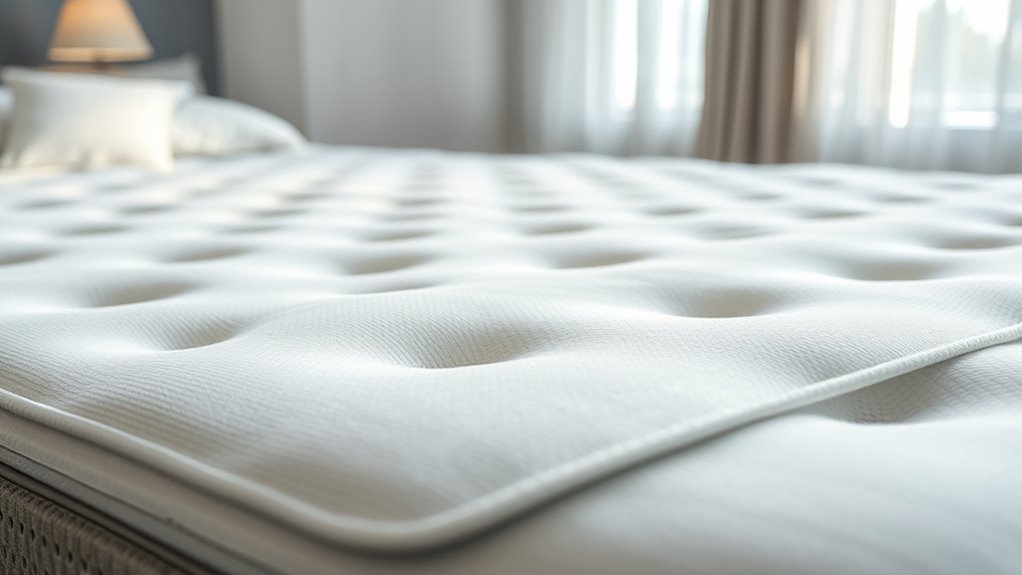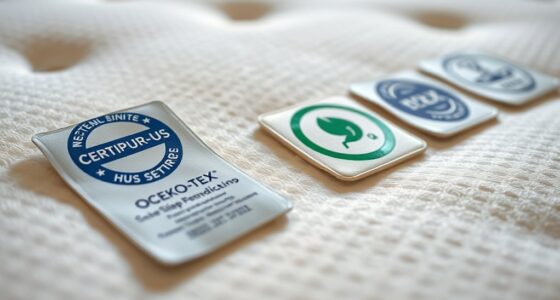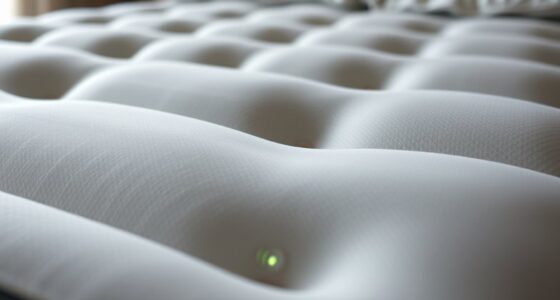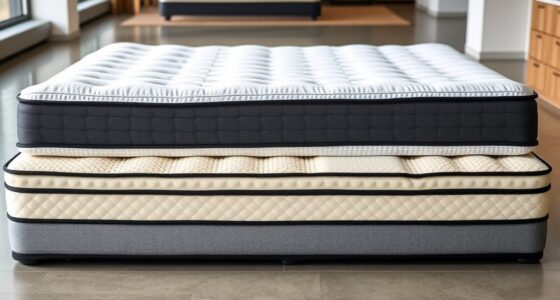Mattress off-gassing happens when chemical emissions from materials like synthetic foams and adhesives release VOCs, creating a strong chemical smell that can linger for days or weeks. This odor indicates emissions that may impact your indoor air quality and comfort. To reduce off-gassing, improve ventilation by opening windows, air out the mattress beforehand, and choose low-VOC or certified mattresses. Staying aware of these strategies can help you create a healthier sleep environment; learn more to protect your indoor air.
Key Takeaways
- Mattress off-gassing involves chemical emissions from materials like foams and adhesives, producing a strong odor that indicates VOC release.
- Persistent chemical smells can affect indoor air quality and may cause discomfort or health concerns during sleep.
- To reduce off-gassing, improve ventilation by opening windows and airing out the mattress before use.
- Choose mattresses with low-VOC certifications such as GREENGUARD Gold or CertiPUR-US for safer, less-emissive options.
- Use air purifiers, maintain low humidity, and regularly clean your bedroom to minimize VOC buildup and off-gassing effects.
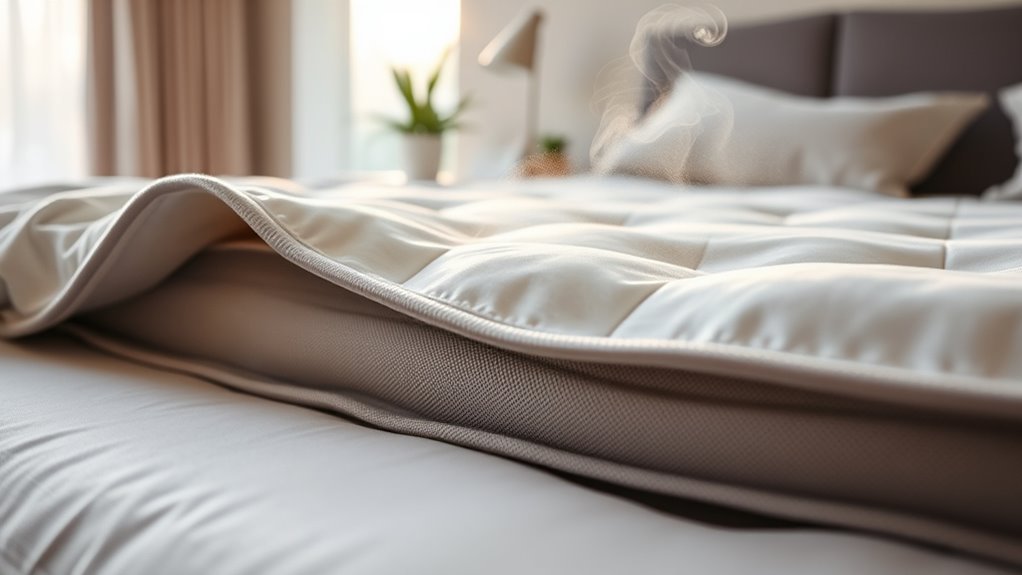
If you’ve recently purchased a new mattress, you might notice a strong chemical smell that lingers for days or even weeks. This odor is a sign of mattress off-gassing, which occurs when chemical emissions are released from the materials used in manufacturing. Many mattresses, especially those made with synthetic foams, adhesives, and flame retardants, contain volatile organic compounds (VOCs). These VOCs evaporate into the air, creating that distinctive smell and potentially causing discomfort or health concerns. Understanding off-gassing helps you recognize that the smell isn’t just an annoyance—it’s a sign of chemical emissions that can affect indoor air quality.
New mattress odors indicate off-gassing of VOCs, which can impact air quality and comfort.
To reduce VOCs and mitigate off-gassing, you should prioritize ventilation. Opening windows and using fans can accelerate the dispersal of chemical emissions, helping to clear out VOCs faster. It’s a simple but effective step that can make your sleeping environment safer and more comfortable. Additionally, consider allowing your mattress to air out in a well-ventilated space before placing it in your bedroom. This process can considerably diminish the intensity of the odors and decrease the amount of VOCs released over time.
Choosing a mattress made with low-emission or VOC-free materials is another key strategy. Many brands now advertise their products as low-VOC or VOC-reduced, which means they emit fewer chemicals during off-gassing. Look for certifications from independent organizations that verify low emissions, such as GREENGUARD Gold or CertiPUR-US. These labels indicate that the mattress has undergone testing and meets strict standards for chemical emissions, helping you make a safer, healthier choice.
You can also take additional steps to minimize off-gassing after your purchase. Using an air purifier equipped with activated carbon or HEPA filters can absorb chemical particles and improve indoor air quality. Regularly cleaning your bedroom and maintaining low humidity levels can also reduce the buildup of VOCs and other airborne pollutants. If the smell persists or worsens, it may be worth considering a different mattress or consulting with the manufacturer about VOC reduction measures. Additionally, understanding the patterns in angel numbers related to love and relationships can offer insights into harmony and positive transitions in your life.
Frequently Asked Questions
How Long Does Mattress Off-Gassing Typically Last?
You’re probably wondering how long the chemical emissions and odor duration from a new mattress last. Typically, off-gassing can take anywhere from a few days to a couple of weeks. To speed up the process, you can increase ventilation, use an air purifier, or let the mattress air out in a well-ventilated space. Most odors will diminish considerably within this time, making your sleep space more comfortable.
Are Natural Mattresses Completely Free of Off-Gassing?
You might think natural mattresses are completely free of chemical emissions, but that’s not always true. While they use organic materials, some may still contain adhesives or treatments that emit low levels of VOCs. Compared to synthetic options, natural mattresses usually off-gas less, offering a healthier sleep environment. However, always check labels and ask about certifications to guarantee minimal chemical emissions and truly organic content.
Can Off-Gassing Cause Long-Term Health Issues?
You might wonder if off-gassing can cause long-term health issues. While brief exposure to indoor air with chemical emissions from new mattresses can cause temporary irritation, most experts agree that prolonged health risks are rare. However, reducing chemical exposure is wise, especially if you’re sensitive. Ventilating your bedroom and choosing natural mattresses can improve indoor air quality, helping you breathe easier and lowering potential long-term health concerns.
Do Air Purifiers Effectively Eliminate Mattress Odors?
Like a detective sniffing out clues, you wonder if an air purifier effectively eliminates mattress odors. While air purifiers can help reduce smells, their effectiveness varies based on the device and odor severity. For thorough odor removal, combine air purifiers with other techniques like ventilation and baking soda. Relying solely on an air purifier might not fully eliminate stubborn mattress odors, so use it as part of your overall odor removal strategy.
Is Off-Gassing Worse With Certain Mattress Materials?
You wonder if certain mattress materials make off-gassing worse. Synthetic chemicals and foam emissions tend to be higher with memory foam and other synthetic mattresses. These materials release volatile organic compounds (VOCs), increasing odors and potential health concerns. Natural latex or organic options usually emit fewer gases, making them better choices if you want to reduce off-gassing. Always check product labels for non-toxic, low-emission materials to minimize exposure.
Conclusion
Now that you know about mattress off-gassing, you hold the key to creating a gust of fresh air in your home. Think of your mattress as a sleeping garden—by taking simple steps, you can clear away the cloudy fumes and let new, clean air flourish. With a little patience and care, you’ll turn your bedroom into a sanctuary where comfort and safety bloom side by side. Breathe easy—your peaceful sleep awaits beyond the haze.
